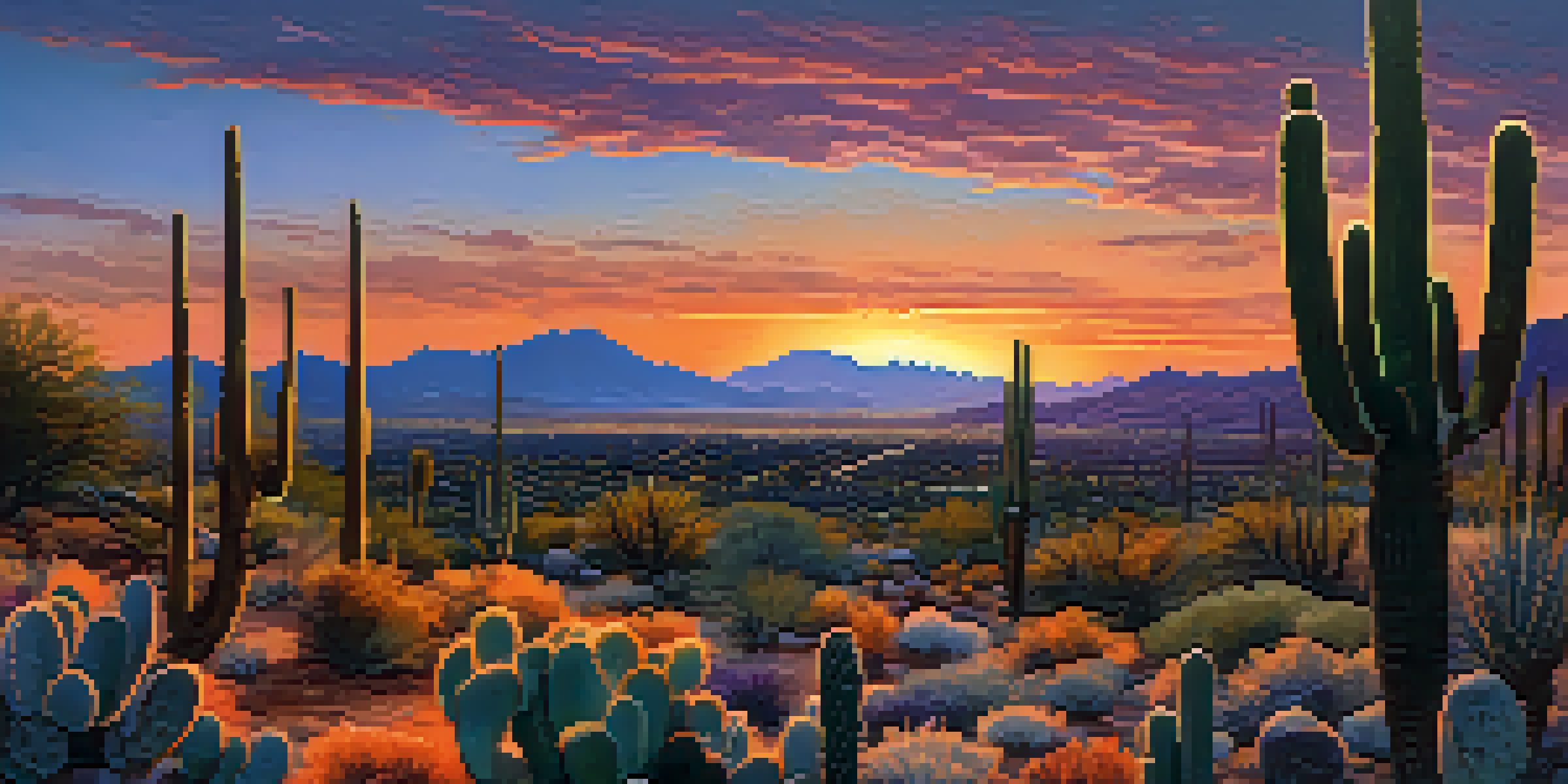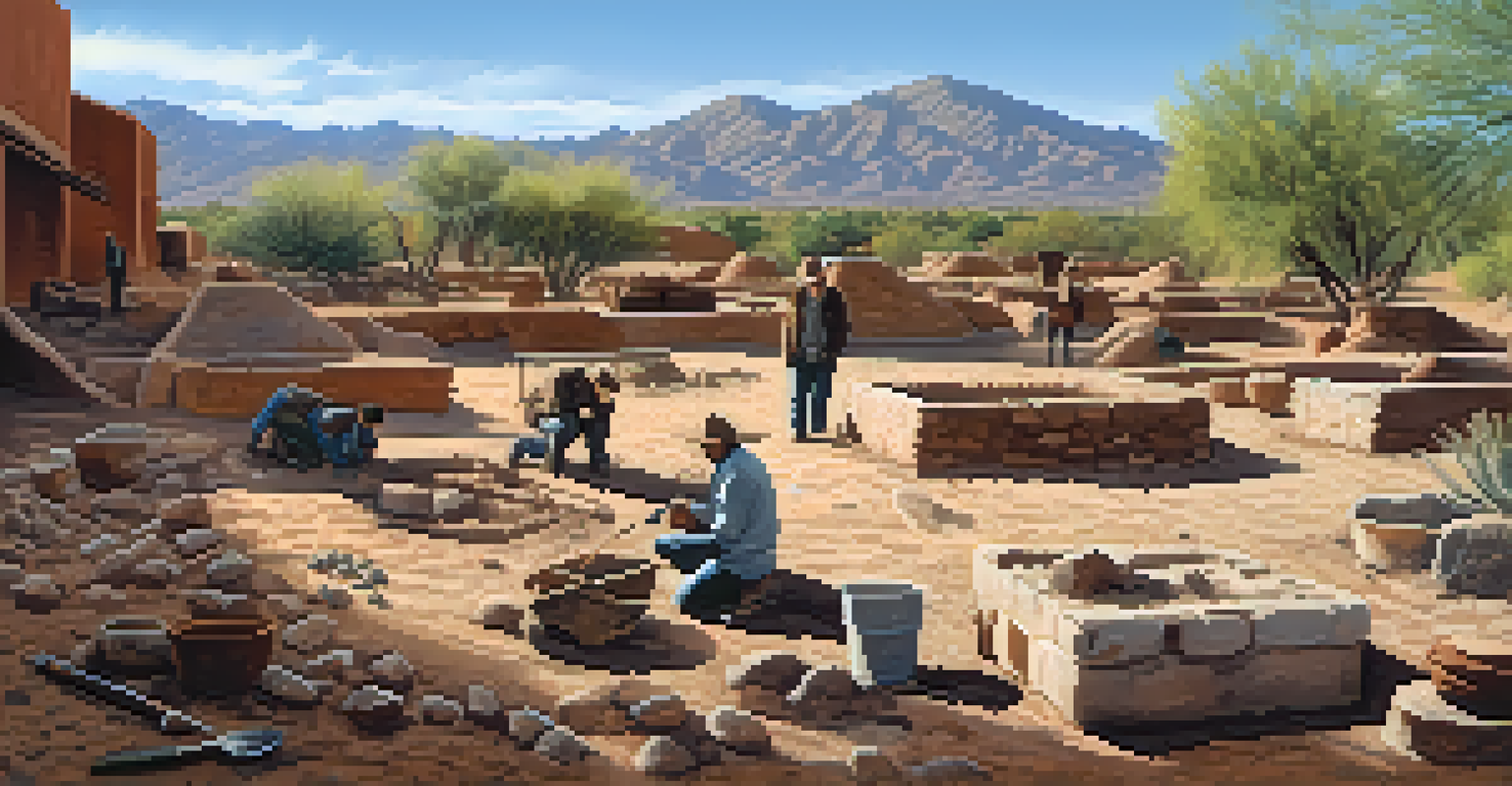Tucson and the Study of Prehistoric Native American Cultures

Understanding Tucson's Geographical Significance
Tucson, nestled in the Sonoran Desert, boasts a unique geographical setting that has shaped its cultural history. Surrounded by mountain ranges and rich biodiversity, this area provided essential resources like water, food, and materials for habitation. These elements attracted early Native American groups, establishing Tucson as a focal point for prehistoric cultures.
The past is not dead; it is not even past.
The region's diverse climate also offered various habitats, catering to different lifestyles and survival strategies. For instance, the availability of cactus fruit and wild game supported hunter-gatherer societies, while nearby rivers fostered agriculture. This geographical advantage made Tucson an ideal location for thriving communities long before European contact.
Understanding this geographical significance helps us appreciate how these early inhabitants adapted to their environment. The interplay between nature and culture is a crucial aspect of Tucson's prehistoric narrative, laying the groundwork for the development of complex societies.
The Influence of the Hohokam Culture
One of the most prominent prehistoric cultures in the Tucson area was the Hohokam, known for their sophisticated irrigation systems. They mastered the art of canal building, allowing them to cultivate crops in the arid desert, which was a remarkable feat for their time. This innovation not only transformed the landscape but also supported a growing population.

The Hohokam were also skilled artisans, creating intricate pottery and jewelry that showcased their cultural identity. Their trade networks extended beyond Tucson, connecting them with other Native American groups across the region. Such interactions contributed to a rich cultural tapestry, influencing art, technology, and social structures.
Tucson's Rich Geographical History
Tucson's unique geographical setting in the Sonoran Desert has shaped its cultural narrative, attracting early Native American groups due to its diverse resources.
Despite their eventual decline around the 15th century, the legacy of the Hohokam lives on in Tucson's archaeological sites. Understanding their achievements provides insights into how prehistoric peoples adapted to their environment and thrived in challenging conditions.
Archaeological Discoveries in Tucson
Archaeological research in Tucson has unveiled a treasure trove of artifacts that help us understand prehistoric Native American cultures. Excavations have revealed everything from pottery shards to tools, offering glimpses into daily life, rituals, and social organization. These artifacts serve as vital links to the past, helping us piece together the stories of those who once inhabited this land.
Culture is the widening of the mind and of the spirit.
One significant site is the Tucson Origins Heritage Park, where researchers have uncovered layers of history dating back thousands of years. This park not only showcases archaeological findings but also educates the public about the region's rich heritage. By engaging with these discoveries, visitors can connect with the ancient cultures that laid the foundations for modern Tucson.
Moreover, ongoing archaeological efforts continue to provide valuable insights into the social dynamics and cultural practices of prehistoric peoples. Each new find adds to our understanding, illustrating how Tucson's narrative is still being written today.
The Role of the Native American Community Today
Today, the Native American community in Tucson plays a vital role in preserving and promoting their cultural heritage. Many descendants of these prehistoric cultures actively engage in cultural revitalization efforts, sharing their traditions through storytelling, art, and community events. This connection to the past fosters a sense of identity and continuity among younger generations.
Institutions like the Arizona-Sonora Desert Museum also contribute by offering programs that educate the public about native cultures. By showcasing traditional crafts, music, and dance, they create a platform for cultural exchange and appreciation. This engagement not only honors the past but also enriches the cultural landscape of Tucson.
Hohokam's Lasting Cultural Impact
The Hohokam culture's advanced irrigation techniques and artistic achievements significantly influenced the region's social structure and cultural identity.
The collaboration between archaeologists and Native American communities is crucial for understanding and respecting the complexities of Tucson's history. Together, they work to ensure that the stories of their ancestors are not forgotten, but rather celebrated and shared with future generations.
Cultural Festivals Celebrating Native Heritage
Tucson hosts several cultural festivals that celebrate Native American heritage, bringing the community together in vibrant displays of tradition. Events like the Tucson Meet Yourself and the All Souls Procession feature Native American music, dance, and art, creating a lively atmosphere that honors indigenous cultures. These festivals not only entertain but also educate attendees about the rich histories and contributions of Native peoples.
Such gatherings provide opportunities for local artisans to showcase traditional crafts, offering a glimpse into the skills passed down through generations. Visitors can engage with artists, learn about their techniques, and even participate in workshops. This hands-on experience fosters a deeper appreciation for the artistry and creativity inherent in Native American cultures.
Moreover, these festivals serve as a platform for dialogue and understanding between different communities. By celebrating diversity and promoting cultural exchange, Tucson continues to honor its rich tapestry of Native American heritage while fostering a sense of unity.
The Legacy of Prehistoric Native American Cultures
The legacy of prehistoric Native American cultures in Tucson is not just a part of history; it continues to shape the identity of the region today. The innovations, traditions, and stories of these early inhabitants have laid the groundwork for contemporary Native American communities and their ongoing contributions to society. Understanding this legacy enriches our appreciation for Tucson's cultural landscape.
As we explore Tucson's history, we see how the past informs the present, from agricultural practices to artistic expressions. Acknowledging this influence fosters a greater respect for the traditions that have survived centuries of change. It encourages a dialogue about the importance of cultural preservation and the ongoing relevance of indigenous knowledge.
Modern Native American Heritage
Today's Native American community in Tucson actively preserves their cultural heritage through storytelling, festivals, and collaborations with archaeological efforts.
Ultimately, the study of prehistoric Native American cultures in Tucson reminds us that history is a living narrative. By honoring and learning from these cultures, we pave the way for a more inclusive future that values the contributions of all communities.
Future Research Directions in Tucson
Looking ahead, the study of prehistoric Native American cultures in Tucson is poised for exciting developments. Ongoing archaeological research, coupled with advancements in technology, promises to uncover even more about the lives of early inhabitants. Methods like ground-penetrating radar and DNA analysis are opening new avenues for understanding cultural practices and migrations.
Collaborative efforts between archaeologists and Native American tribes will be crucial in guiding future research. By incorporating indigenous knowledge and perspectives, researchers can gain richer insights into the historical context and significance of their findings. This partnership not only enhances scientific understanding but also fosters mutual respect and cultural sensitivity.

As we delve deeper into Tucson's prehistoric past, we can expect to learn more about the resilience and ingenuity of its Native American cultures. This ongoing journey of discovery will continue to enrich our understanding of this vibrant region and its remarkable heritage.